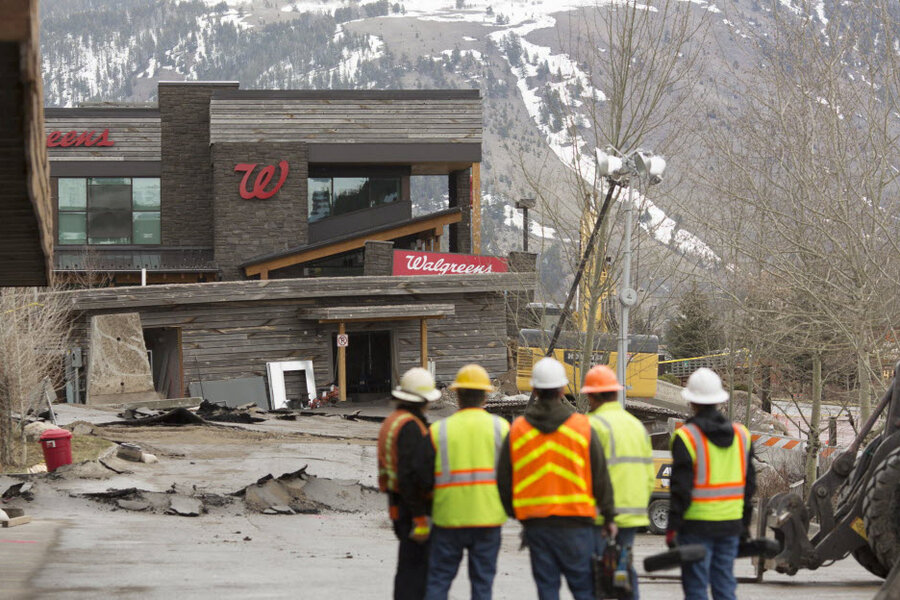Jackson Hole landslide slowly swallows Wyoming town
Loading...
| Jackson, Wyo.
A slow-motion disaster continued unfolding in the Wyoming resort town of Jackson on Saturday, as a creeping landslide that split a hillside home threatened to swallow up more houses and businesses.
The ground beneath the 100-foot hillside had been slowly giving way for almost two weeks before the downward movement accelerated in recent days.
With rocks and dirt tumbling down, officials suspended efforts to shore up the slope and said they were uncertain what else could be done.
"When is it going to go? How long is it going to last? These are the questions we just can't answer and they're what everyone wants to know," town spokeswoman Charlotte Reynolds said.
Authorities said there could be a variety of causes for the slide, including prior construction at the site, warmer weather and a wet winter that put more water into the ground where it acts as a lubricant for unstable rocks and soil.
Experts say the hillside is unlikely to suddenly collapse like the March 22 landslide in Oso, Wash., that killed 39 people. More likely, large blocks of earth would tumble down piece by piece.
But the threat is real and authorities are enforcing an evacuation order in hopes of avoiding injuries. Town officials first noticed significant hill movement April 4. They evacuated 42 homes and apartment units April 9.
By Saturday morning, the shifting earth had bulged a road and a parking lot at the foot of the hill by as much as 10 feet. The groundswell pushed a small town water pump building 15 feet toward West Broadway, the town's main drag.
The ground had been moving at a rate of an inch a day but is expected to move increasingly faster as time goes on, said George Machan, a landslide specialist consulting for the town.
Rockslides are common throughout the Rocky Mountains in the spring, as melting snow and warmer weather unleashes the region's dynamic geology. In the early 1900s, a massive slide caused by heavy rains north of Jackson formed a natural dam across a small river. The dam gave way two years later, unleashing a flood that killed six people.
But other factors appear to be in play on Jackson's East Gros Ventre Butte, a small mountain that looms over the west side of town, its base dotted with homes and businesses.
The area of the landslide has been graded for roads and businesses in recent years, including a new Walgreens. That could have weakened the hillside and set the stage for the landslide, although the precise trigger remains under investigation.
Jackson resident Rick Johnson lives less than a quarter-mile from the slide area along the same south-facing butte. He said a retaining wall on his property has been shifting in recent years, but he had not given it too much thought until the slide started just down the road.
As he watched workers at the top of the slide area taking measurements of the previous night's movements, Johnson said he had no doubt that the natural geologic forces at work were amplified by the construction at the foot of the mountain.
"I think they are just messing with Mother Nature and they didn't think of the long-term consequences," he said.
Unlike an earthquake or tornado, landslides typically are isolated and don't affect large swaths of territory. Yet they consistently rate among the costliest, most frequent and deadliest natural disasters in the U.S., said David Montgomery, a geology professor at the University of Washington in Seattle.
They occur in all 50 states, kill 25-50 people a year and cost $1 billion to $3 billion a year, he said, citing a 2004 National Research Council report.
Landslides in scenic, mountainous areas like Jackson are a lot like the wildfires that occur in the same areas. Both hazards are natural events that present more of a problem when people move in and build subdivisions or shopping areas.
"When you add it up, it's actually a major geological hazard," Montgomery said. "As more people move into more mountainous environments, the opportunities for interactions between human infrastructure and people, and landslides, increase."
In other areas, such as around Puget Sound in Washington state, entire neighborhoods have been built upon old landslides that are no longer moving — and may or may not move again.
Still other landslides, he said, occur so slowly that highways are built over them. The highways get rebuilt, again and again, to compensate for the movement.
Mead Gruver reported from Cheyenne





